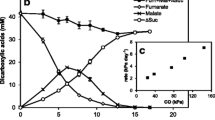Abstract
The anaerobic, photosynthetic bacteriumChlorobium thiosulfatophilum utilizes CO2 as its carbon source and operates at the mesophilic temperature of 30‡C. It requires incandescent light for growth and compounds such as H2S, S‡, S2O3 2−, or H2 as a source of electrons. Of these compounds, H2S as sulfide is the preferred electron donor, with other compounds utilized only when sulfide has been depleted from the medium. The organism is also capable of indirectly utilizing carbonyl sulfide (COS), since COS reacts with water to form CO2 and H2S. This work presents kinetic information on the rate of growth ofC. thiosulfatophilum, as well as the rates of uptake of both H2S and COS. The growth is dependent on light intensity according to a Monod type relationship.
Similar content being viewed by others
Abbreviations
- B, Constant:
-
h−1 lux
- Io :
-
Light intensity, lux
- Kt :
-
Constant lux
- Μ:
-
Specific growth rate, h−1
- Μm :
-
Maximum specific growth rate, h−1 (Constant in Eq. (5))
- Μ′m :
-
Maximum specific growth rate, h−1 (Constant in Eq. (6))
- X:
-
Dry weight cell concentration, mg 1−1
- Xo :
-
Initial dry weight cell concentration, mg 1−1
References
Eickmeyer, A.G. and Gangriwala, H. A. (1981),Energy Prog. 1, 9.
Galstaun, L. S. and Geosits, R. F. (1986),Energy Prog. 5, 156.
Kohl, A. L. and Riesenfeld, F. C. (1985),Gas Purification, 4th ed., Gulf Publishing, Houston, TX, pp. 29–246.
Caillet, M. and Galerie, A. (1980),Ceram. 30, 171.
Sublette, K. L. and Sylvester, N. D. (1986),Biotechnol. Bioeng. Symp. Ser. 17, 543.
Cork, D. J. and Szuchen, M. (1982),Biotechnol. Bioeng. Symp. Ser. 12, 285.
Maka, A. and Cork, D. (1990),J. Ind. Microbiol. 5, 337.
Kim, B. W., Kim, I. K., and Chang, H. N. (1990),Biotechnol. Lett. 12(5), 381.
Kim, B. W. and Chang, H. N. (1991),Biotechnol. Prog. 7, 495.
Kim, B. W., Chang, H. N., Kim, I. K., and Lee, K. S. (1992),Biotechnol. Bioeng. 40, 583.
Smith, K. D., Klasson, K. T., Ackerson, M. D., Clausen, E. C., and Gaddy, J. L. (1991),Appl. Biotechnol. Bioeng. 28/29, 787.
McInerney, M. J., Bryant, M. P., and Pfennig, N. (1979),Arch. Microbiol. 122, 129.
Genthner, B. R. S., Davis, M. P., and Bryant, M. P. (1981),Appl. Environ. Microbiol. 42, 1.
Costilow, R. N. (1981), inManual of Methods for General Bacteriology, Gerhardt, P. et al., eds., American Society for Microbiology, Washington, DC, p. 66.
Staley, J. T. ed. (1989),Bergey’s Manual of Systematic Bacteriology, vol. 3, Williams & Wilkins, Baltimore, p. 1686.
Thompson, H. W., Kearton, C. F., and Lamb, S. A. (1935),J. Chem. Soc. Part II, 1033.
Klasson, K. T., Lundback, K. M. O., Clausen, E. C., and Gaddy, J. L. (1993),J. Biotechnol. accepted for publication.
Cohen-Bazire, G. and Sistrom, W. R. (1966), inThe Chlorophylls, Vernon, L. P., and Seely, G. R., eds., Academic Press, New York, p. 313.
Smith, K. D. (1990), The Biological Removal of Carbonyl Sulfide from Coal Derived Synthesis Gas, MS Thesis, U. of Arkansas.
Author information
Authors and Affiliations
Rights and permissions
About this article
Cite this article
Basu, R., Klasson, K.T., Clausen, E.C. et al. Removal of carbonyl sulfide and hydrogen sulfide from synthesis gas byChlorobium thiosulfatophilum . Appl Biochem Biotechnol 45, 787–797 (1994). https://doi.org/10.1007/BF02941849
Issue Date:
DOI: https://doi.org/10.1007/BF02941849




